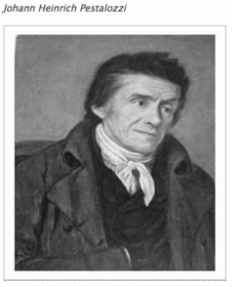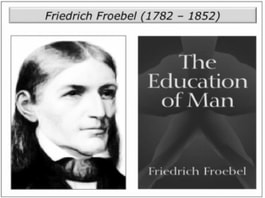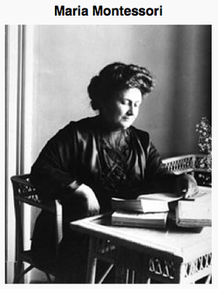All people are born Natural Learners.
"Real Learning" does not take place without the active engagement of the learner.
Balanced Learning is a multi-sensory activity.
Creative Materials and Environments positively effect learning.
The most fundamental role of a teacher is to nurture and encourage self motivated discovery.
"Real Learning" does not take place without the active engagement of the learner.
Balanced Learning is a multi-sensory activity.
Creative Materials and Environments positively effect learning.
The most fundamental role of a teacher is to nurture and encourage self motivated discovery.
Our World Desparately Needs Profound Improvements In Education.
The following articles are the historical foundation of Rutherfurd Laboratories philosophy regarding educational theory and practice.
These Pioneers of Modern Education and their "simple ideas" summarized here are as profound today as they were so long ago.
The following articles are the historical foundation of Rutherfurd Laboratories philosophy regarding educational theory and practice.
These Pioneers of Modern Education and their "simple ideas" summarized here are as profound today as they were so long ago.

Comenius, who lived from 1592 to 1670, was a Moravian theologian and educator who became bishop of the Unity of Brethren. Traveling all over Europe, he dedicated himself to helping students learn. He also implored all people to recognize they were part of one human family.
Comenius is considered by many to be ‘the father of modern education’. He believed in providing education for all children – both girls and boys – not just those from richer families. He produced the first picture book for children and his books were translated into the major European Languages.
Here are some of the best known quotes from his book The Great Didactic (sometimes known as... The Whole Art of Teaching)
Learning is Natural - “Who is there that does not always desire to see, hear, or handle something new? To whom is it not a pleasure to go to some new place daily, to converse with someone, to narrate something, or have some fresh experience?”
“In a word, the eyes, the ears, the sense of touch, the mind itself, are, in their search for food, ever carried beyond themselves …”
“The proper education of the young does not consist in stuffing their heads with a mass of words, sentences, and ideas dragged together out of various authors, but in opening up their understanding to the outer world, so that a living stream may flow from their own minds, just as leaves, flowers, and fruit spring from the bud on a living tree.” [1] [*]
Comenius is considered by many to be ‘the father of modern education’. He believed in providing education for all children – both girls and boys – not just those from richer families. He produced the first picture book for children and his books were translated into the major European Languages.
Here are some of the best known quotes from his book The Great Didactic (sometimes known as... The Whole Art of Teaching)
Learning is Natural - “Who is there that does not always desire to see, hear, or handle something new? To whom is it not a pleasure to go to some new place daily, to converse with someone, to narrate something, or have some fresh experience?”
“In a word, the eyes, the ears, the sense of touch, the mind itself, are, in their search for food, ever carried beyond themselves …”
“The proper education of the young does not consist in stuffing their heads with a mass of words, sentences, and ideas dragged together out of various authors, but in opening up their understanding to the outer world, so that a living stream may flow from their own minds, just as leaves, flowers, and fruit spring from the bud on a living tree.” [1] [*]

Pestalozzi, who lived from 1746 to 1827, this Swiss educator believed in offering all children the opportunity of a good education. Pestalozzi explained his approach in a book called How Gertrude Teaches Her Children: An attempt to help mother to teach their children and an account of the method. He thought it was vital:
To recognize that each child’s personality is sacred.
To provide a safe environment in which children could learn (no flogging!).
To include the five senses in the learning process. He believed it called for providing learning that connected the hand, heart and head. This also meant learning both indoors and outdoors.
To start with concrete work – then move to abstraction. This called for an emphasis on learning by doing, clarifying the thinking and then practicing.
To recognize that love of learning will continue to drive learning far into the future.
Pestalozzi believed in encouraging children to think for themselves. [1] [*]
To recognize that each child’s personality is sacred.
To provide a safe environment in which children could learn (no flogging!).
To include the five senses in the learning process. He believed it called for providing learning that connected the hand, heart and head. This also meant learning both indoors and outdoors.
To start with concrete work – then move to abstraction. This called for an emphasis on learning by doing, clarifying the thinking and then practicing.
To recognize that love of learning will continue to drive learning far into the future.
Pestalozzi believed in encouraging children to think for themselves. [1] [*]

Froebel, The pioneer who gave birth to the kindergarten - ‘the children’s garden’
Froebel believed children need a "place" where they could be cherished, stimulated and helped to flourish. His genius and deep inspiration will forever inform and benefit the art and science of educational practice.
His ideas were adopted by many "ambassadors" who spread the materials and methods he developed across the globe. These influenced the upbringing of people such as Frank Lloyd Wright, Buckminster Fuller, Paul Klee, Wassily Kandinsky, Enid Blyton and Bertrand Russell.
Writing in The Education of Man, Froebel explained:
“The mind grows by self revelation. In "play" the child ascertains what he can do, discovers his possibilities of will and thought by exerting his power spontaneously. In the "work place" he all to often follows a task prescribed for him by another, and does not reveal his own proclivities and inclinations – but another’s. In play he reveals his own original power.”
Froebel designed a series of wooden block called "Gifts" which were set up as centers and allowed children to engage in independent studies. “The blocks can be arranged to form patterns of symmetry and harmony. Froebel also called this dancing as the blocks are progressively rearranged to reveal evolving patterns of increasing complexity.”
Froebel believed that each child had their own rhythm. They would learn when they were ready to learn. The educator’s role was to provide the encouragement and stimulation to help them develop.
It is vital to give each child the opportunity to explore different materials, create new things and achieve a sense of completion.
People can be helped to develop through play and other creative activities.
Creative people retain a sense of play. They love to follow their passion, pursue possibilities and create finished products. Play can be a starting point for creativity, but progress does not always come easily. Doing what you love can involve overcoming tough challenges. Creative people do what they enjoy but they also love to ‘sweat’. They gain a great sense of satisfaction from completing a task that adds to life, knowledge or beauty. [1] [*]
Froebel believed children need a "place" where they could be cherished, stimulated and helped to flourish. His genius and deep inspiration will forever inform and benefit the art and science of educational practice.
His ideas were adopted by many "ambassadors" who spread the materials and methods he developed across the globe. These influenced the upbringing of people such as Frank Lloyd Wright, Buckminster Fuller, Paul Klee, Wassily Kandinsky, Enid Blyton and Bertrand Russell.
Writing in The Education of Man, Froebel explained:
“The mind grows by self revelation. In "play" the child ascertains what he can do, discovers his possibilities of will and thought by exerting his power spontaneously. In the "work place" he all to often follows a task prescribed for him by another, and does not reveal his own proclivities and inclinations – but another’s. In play he reveals his own original power.”
Froebel designed a series of wooden block called "Gifts" which were set up as centers and allowed children to engage in independent studies. “The blocks can be arranged to form patterns of symmetry and harmony. Froebel also called this dancing as the blocks are progressively rearranged to reveal evolving patterns of increasing complexity.”
Froebel believed that each child had their own rhythm. They would learn when they were ready to learn. The educator’s role was to provide the encouragement and stimulation to help them develop.
It is vital to give each child the opportunity to explore different materials, create new things and achieve a sense of completion.
People can be helped to develop through play and other creative activities.
Creative people retain a sense of play. They love to follow their passion, pursue possibilities and create finished products. Play can be a starting point for creativity, but progress does not always come easily. Doing what you love can involve overcoming tough challenges. Creative people do what they enjoy but they also love to ‘sweat’. They gain a great sense of satisfaction from completing a task that adds to life, knowledge or beauty. [1] [*]

Montessori, who lived from 1870 to 1952 was an Italian physician and educator best known for the philosophy of education that bears her name, and her writing on scientific pedagogy. Her educational method is in use today in public and private schools throughout the world.
Montessori realized that despite her life long devotion to the advancement of eduction she would not be able to develop the best possible school or supporting materials. Thus she proposed and set up Montessori schools as Scientific "Teaching and Learning Laboratories" in which "Educational Experiments" could be conducted and recorded to determine the absolutely best methods - generally or for a specific community of students or society. Her idea was that schools would systematically be improved based on their experiences as well as the analysis of detailed data collection regarding the failures and successes of various supplemental materials or employed methodologies.
Montessori education is characterized by an emphasis on independence, freedom within limits, and respect for a child’s natural psychological, physical, and social development. Although a range of practices exists under the name "Montessori", the Association Montessori Internationale (AMI) and the American Montessori Society (AMS) cite these elements as essential to Montessori education:
Mixed age classrooms
Student choice of activity from within a prescribed range of options.
Uninterrupted blocks of work time, ideally three hours.
A constructivist or "discovery" model, where students learn concepts from working with materials, rather than by direct instruction.
Specialized educational materials developed by Montessori and her collaborators.
Freedom of movement within the classroom.
A trained Montessori teacher. [2][3][*]
References .
[1] The text references an article called Friedrich Froebel’s Work On Strengths published on the website of "The Strengths Foundation".
http://www.thestrengthsfoundation.org/3-tips-for-understanding-friedrich-froebels-work-on-strengths
[2] "AMI School Standards". Association Montessori Internationale-USA (AMI-USA).
[3] "Introduction to Montessori". American Montessori Society (AMS).
[*] The previous citations are well established in ample historical texts and modern day journals and websites.
[1] The text references an article called Friedrich Froebel’s Work On Strengths published on the website of "The Strengths Foundation".
http://www.thestrengthsfoundation.org/3-tips-for-understanding-friedrich-froebels-work-on-strengths
[2] "AMI School Standards". Association Montessori Internationale-USA (AMI-USA).
[3] "Introduction to Montessori". American Montessori Society (AMS).
[*] The previous citations are well established in ample historical texts and modern day journals and websites.
Please see our Articles Page for more information regarding our Philosophy of
Education and its Theory and Practice.
Education and its Theory and Practice.
